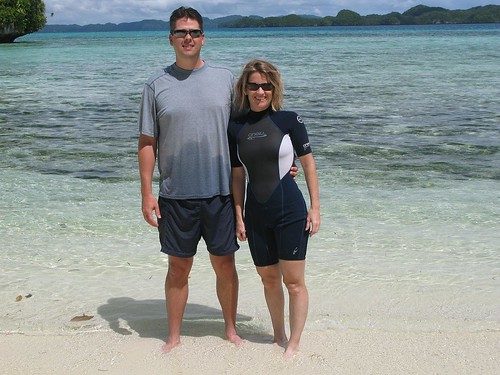Getting there involved about 90 minutes of discouraging driving: Instead of thick jungle terrain, there was mile after mile of palm tree plantations (for palm oil). Uniform rows of palm trees extended as far as the eye could see in every direction - like a terrible infection spreading across the land. Later, on the bus ride away from Sipidan, the blight continued for hours more in the other direction. No wildlife here! And sad to think that the need for alternative energy that I strongly support could inadvertently drive the spread of palm plantations for "bio" fuel production - a very bad solution from this perspective. But on to Sipidan...
The diving was great! We saw dozens of sea turtles: The green turtles let you scratch their back; the hawksbill do not. There were giant "bait balls" of Jacks and of Barracuda. These are swirling masses of a thousand fish swimming together in a giant ball shape - so dense it is dark. As you approach, the giant ball envelops and surrounds - very cool! (see it in motion here)
But perhaps the best sighting in Sipidan was of a whale shark. These gentle giants grow to 40 feet long (size of a bus), but this one was just a twelve foot long baby. It is a filter-feeder, so there is no danger. We are still hoping to see an adult someday, but whale sharks are elusive.
Next, a jungle boat excursion on the Kinabatangan river provided the chance to see lots more Proboscis monkeys and macaques. But the highlight was finding a courting pair of wild orangutans perched high in a tree beside the river. Seeing an orangutan in the wild is quite rare, so we were very happy to get to see them - it was one of the reasons we included Borneo on our trip.
Watching the different primates was fascinating. Orangutans high in a tree will use their body weight to rock it back and forth until they can reach the tip of a neighboring branch. The branch is then reeled in to bring a stronger limb (or the trunk) close enough to climb across. The Proboscis monkeys also rock back and forth, but when they feel close enough, they leap across for the neighboring tree. But the Macaques are crazy jumpers! They seem not to care at all about their destination - they just jump as far as they can and grab a handful of whatever they find when they get there. They were all like superheroes up in the trees: Turns out that an Orangutan is 3-6 times stronger than a man.
We also did a few hikes along the river through the deep jungle mud. We had hoped to see wild Pygmy elephants (or a very rare Sumatran rhinoceros), but instead we were besieged by leeches. I've never encountered leeches before, and I had no idea what we were in for. These critters are much bigger, faster moving, and craftier than I had imagined. They drop on to you from their perch underneath a leaf as you brush by. Then they relentlessly stretch and wiggle their way into the seams or edges of your clothing and search for bare skin. With some sort of natural anesthesia and anticoagulant, they painlessly bite into you and start filling with blood. Sorry, there are no pictures of the leeches, as they were always too urgently dispatched. I lost a few milliliters of blood to these foul creatures on my ankle and toe, and then proceeded to bleed slowly into my socks for hours afterward.
Every hike ended with a "leech check," where we inspected each other clothed and then naked for unwanted hitchhikers. We missed two of them one night until we reached our room and promptly flushed them down the toilet. Bad idea! A minute later they came climbing up the side of the bowl. Could have been really bad timing! Another flush brought the same result, so we had to take them outside.
From the jungles of Borneo, we made our way to our departure city. Our trip home has taken 52 hours: From Kota Kinabalu to San Diego (thru Manilla, Tokyo, Atlanta, and LA). While quite arduous, the long trip back did give us a chance to slowly re-adjust to civilization as we know it.
Settling in at home has been wonderful - we live in a truly delightful place, and there is so much to appreciate. We feel very fortunate to have had the opportunity to take this trip. Enriched by experiences I had never imagined, I hope to carry a new appreciation for keeping life simple and for the freedoms and prosperity of our democracy. Thanks for following along with us.
P.S. Upon our arrival in Los Angeles, the pilot announced that we were carrying a fallen soldier home from Iraq. Everyone remained seated as the soldier accompanying him departed the plane first, and it was a tear-jerking moment to see the rows of uniformed men and women standing in formation on the tarmac below. It is the closest I've been to the terrible sacrifices being made (profoundly sadder for the ignorant policies that caused it).
P.P.S. Here are some final figures to summarize the trip: 7 countries, 74 days, 21 flights (24,870 miles), 6 buses (1,364 miles), and 0 days of food poisoning.
P.P.P.S. The final slide show of our best Borneo photos is here.







































